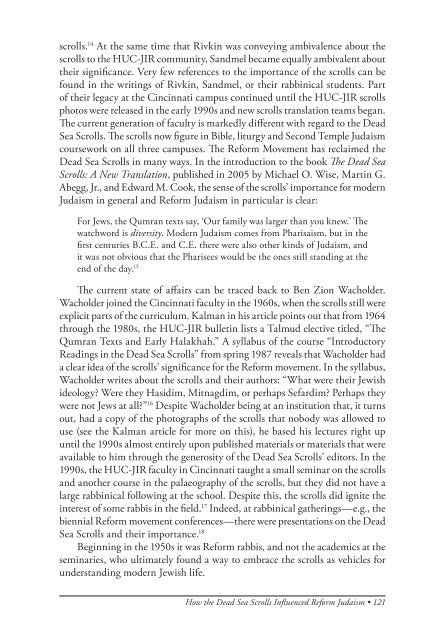The American Jewish Archives Journal, Volume LXI 2009, Number 1
The American Jewish Archives Journal, Volume LXI 2009, Number 1
The American Jewish Archives Journal, Volume LXI 2009, Number 1
You also want an ePaper? Increase the reach of your titles
YUMPU automatically turns print PDFs into web optimized ePapers that Google loves.
scrolls. 14 At the same time that Rivkin was conveying ambivalence about the<br />
scrolls to the HUC-JIR community, Sandmel became equally ambivalent about<br />
their significance. Very few references to the importance of the scrolls can be<br />
found in the writings of Rivkin, Sandmel, or their rabbinical students. Part<br />
of their legacy at the Cincinnati campus continued until the HUC-JIR scrolls<br />
photos were released in the early 1990s and new scrolls translation teams began.<br />
<strong>The</strong> current generation of faculty is markedly different with regard to the Dead<br />
Sea Scrolls. <strong>The</strong> scrolls now figure in Bible, liturgy and Second Temple Judaism<br />
coursework on all three campuses. <strong>The</strong> Reform Movement has reclaimed the<br />
Dead Sea Scrolls in many ways. In the introduction to the book <strong>The</strong> Dead Sea<br />
Scrolls: A New Translation, published in 2005 by Michael O. Wise, Martin G.<br />
Abegg, Jr., and Edward M. Cook, the sense of the scrolls’ importance for modern<br />
Judaism in general and Reform Judaism in particular is clear:<br />
For Jews, the Qumran texts say, ‘Our family was larger than you knew.’ <strong>The</strong><br />
watchword is diversity. Modern Judaism comes from Pharisaism, but in the<br />
first centuries B.C.E. and C.E. there were also other kinds of Judaism, and<br />
it was not obvious that the Pharisees would be the ones still standing at the<br />
end of the day. 15<br />
<strong>The</strong> current state of affairs can be traced back to Ben Zion Wacholder.<br />
Wacholder joined the Cincinnati faculty in the 1960s, when the scrolls still were<br />
explicit parts of the curriculum. Kalman in his article points out that from 1964<br />
through the 1980s, the HUC-JIR bulletin lists a Talmud elective titled, “<strong>The</strong><br />
Qumran Texts and Early Halakhah.” A syllabus of the course “Introductory<br />
Readings in the Dead Sea Scrolls” from spring 1987 reveals that Wacholder had<br />
a clear idea of the scrolls’ significance for the Reform movement. In the syllabus,<br />
Wacholder writes about the scrolls and their authors: “What were their <strong>Jewish</strong><br />
ideology? Were they Hasidim, Mitnagdim, or perhaps Sefardim? Perhaps they<br />
were not Jews at all?” 16 Despite Wacholder being at an institution that, it turns<br />
out, had a copy of the photographs of the scrolls that nobody was allowed to<br />
use (see the Kalman article for more on this), he based his lectures right up<br />
until the 1990s almost entirely upon published materials or materials that were<br />
available to him through the generosity of the Dead Sea Scrolls’ editors. In the<br />
1990s, the HUC-JIR faculty in Cincinnati taught a small seminar on the scrolls<br />
and another course in the palaeography of the scrolls, but they did not have a<br />
large rabbinical following at the school. Despite this, the scrolls did ignite the<br />
interest of some rabbis in the field. 17 Indeed, at rabbinical gatherings—e.g., the<br />
biennial Reform movement conferences—there were presentations on the Dead<br />
Sea Scrolls and their importance. 18<br />
Beginning in the 1950s it was Reform rabbis, and not the academics at the<br />
seminaries, who ultimately found a way to embrace the scrolls as vehicles for<br />
understanding modern <strong>Jewish</strong> life.<br />
How the Dead Sea Scrolls Influenced Reform Judaism • 121

















